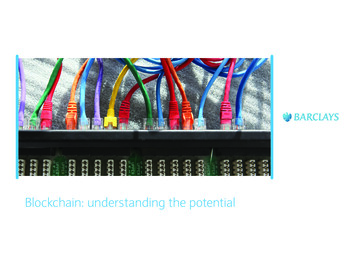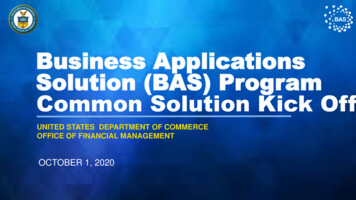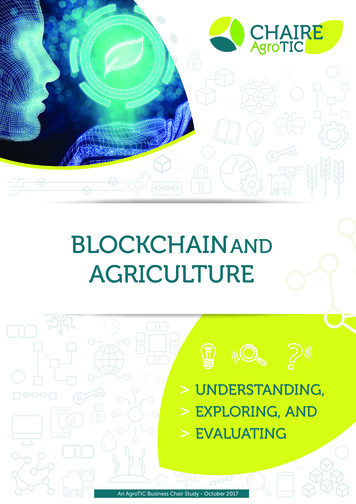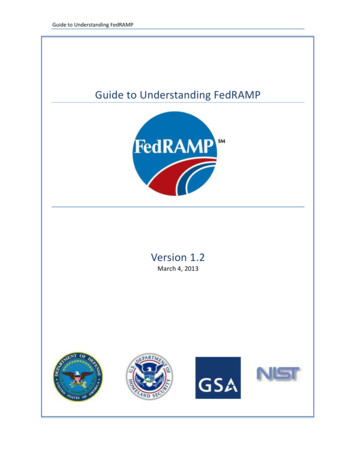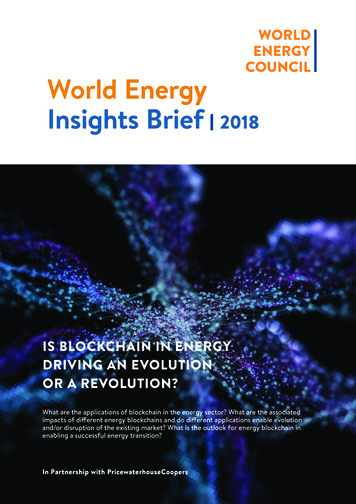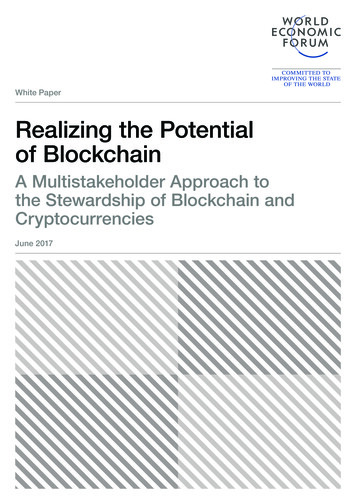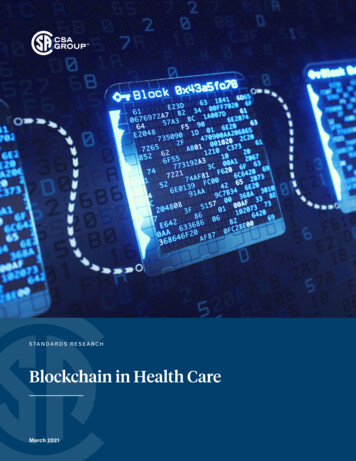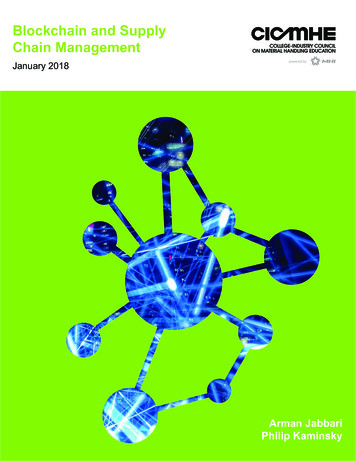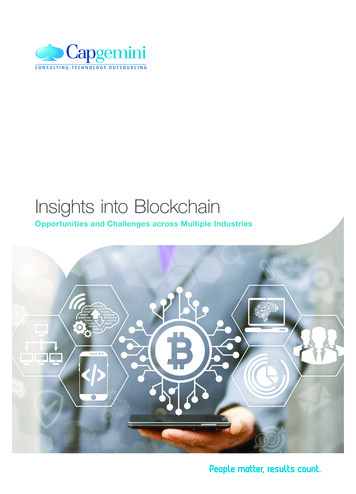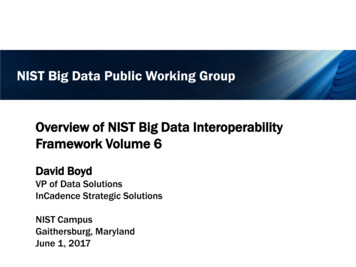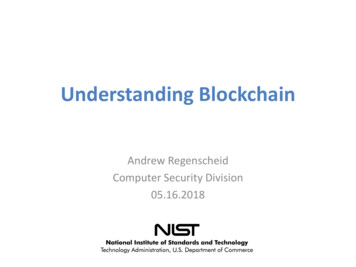
Transcription
Understanding BlockchainAndrew RegenscheidComputer Security Division05.16.2018
“Explain to me how Bitcoin works.” lain-to-me-how-bitcoin-works/FCSM Forum2
Prologue: Distributed Ledger ExampleAlice and Bob playing Chess by Mail– Alice sends Bob “1 e4”– Bob sends back “1 . e5”– Alice sends Bob “2 Nf3”If they don’t agree on the state of the board, they can’t play a game!1.Both know the starting positions of the board.2.Both know the sequence of messages so far (i.e., the moves)3.Thus, they can reconstruct the state of the board.If we agree on history, we agree on the present state of the world!FCSM Forum3
What’s that got to do with Blockchain?A blockchain lets us agree on the state of the system, even ifwe don’t all trust each other! Ultimate goal: We all need to agree on the state of somesystem– How much BTC in each account?– Who owns which property?– What’s the current state of my program? We can all agree on that if we agree on history– Starting state history current state We don’t want a single trusted arbiter of the state of theworld– We want some level of decentralization—not a single point offailure or compromiseFCSM Forum4
Blockchain is A distributed ledger which is: Decentralized Peer-to-peer Tamper-evident/resistant Synchronized throughconsensusFacilitate transactions between mutually-distrustingentities without the need for a trusted arbiterFCSM Forum5
Blockchains- How do they work? Transactions arerecorded in a sequenceof blocks Linked together througha hash chainFCSM Forum6
Hash chains Blocks are cryptographically chained together A change in any block breaks the chain, providing tamper-evidence If the chain is broadly distributed, we can identify the valid chain,providing tamper-resistanceFCSM Forum7
So, What’s a Blockchain?A blockchain is a sequence of hash-chained recordsalong with: Validity conditions for new blocks– Are transactions valid? Are digital signatures correct? Defined procedures for adding blocks– Who gets to add blocks? How is it done? Consensus algorithms to agree on the state whenconflicts arise– When Alice and Bob have different pictures of history, there’s someway for them to eventually come to agreement about who is right.FCSM Forum8
Blockchain Architectures Permissionless blockchains– Bitcoin– Ethereum– Zcash Permissioned blockchains– Hyperledger Fabric– QuorumFCSM Forum9
Permissionless BlockchainsCharacteristics: Participation open to the public Peer-to-peer transactions Typically tied to cryptocurrency Fully decentralizedChallenges: Privacy and scalingPermissionless blockchains are a disruptive technology thatcan dramatically change how we conduct business activities.FCSM Forum10
Permissioned BlockchainsCharacteristics: Participation can be private and/or controlled Trusted participants More efficient than many public blockchains Can support privacy and confidentiality in transactionChallenges: Some level of centralized trust through governing authorityPermissioned blockchains may lead to cost-savings,workflow improvements, automation and improved auditingwith current business processes.FCSM Forum11
Case Study- BitcoinBitcoin is the first decentralized digital currency, built onBlockchain technology. Assets: Bitcoin Transactions: payments between accountsHow does Bitcoin handle: Validity conditions for new blocks? Defined procedures for adding blocks? Consensus algorithms to agree on the state when conflictsarise?FCSM Forum12
Case Study- Bitcoin (1)What are valid blocks of transactions? Conditions– Transactions must be valid Signatures needed for moving BTC from an account Not allowed to leave a negative balance in an account– Block must contain a valid proof-of-work Anyone can verify the validity of a block A proposed block that doesn’t meet these conditionswon’t be accepted by the rest of the networkEnforced by consensusFCSM Forum13
Case Study- Bitcoin (2)Who can add a block? Transactions from Bitcoin users are broadcast to all nodes Nodes bundle these transactions in blocks Any node can add a block with a valid proof-of-workPayCarol 8DawnDawn Carol: 8Eve Bob: 3Frank Alice : 5Pay Bob 3Pay Alice 5Bitcoin Miner/NodeFrankFCSM ForumEve14
Proof-of-Work Perform a big computation when adding blocks– Expensive to perform by the proposing node– Cheap to verify by all others Why is this useful?– Limits the rate of new blocks– Makes attempts to add invalid blocks expensive– Provides a way to decide between competing chains- thechain with the most work winsFCSM Forum15
Bitcoin Mining Mining: the process of adding blocks to the Bitcoin blockchain– Integral to bitcoin: only way to add transactions– Expensive: must complete a proof-of-work per block Mining Incentives: The miner that adds a new block is paid:– Mining Reward: Currently 12.5 BTC– Transaction Fees: Small payments to miners from payers to incentivizeinclusion of their transaction in a block Miners are only rewarded if blocks are accepted– Blocks containing invalid transactions will be rejected by other nodes– Strong incentive to play by the rulesFCSM Forum16
Case Study- Bitcoin (3)How do you settle disagreements?When two or more valid chains exist, the longest chain winsConsensus Orphaned blockBlock3’Block4’Orphaned blocksFCSM Forum17
Bitcoin IncentivesThe real genius in Bitcoin’s design is the way incentives arealigned: Untrusted, self-interested miners keep the system working They have a big incentive to follow the protocol They have substantial capital invested in Bitcoin, so they alsohave an incentive to avoid any attack that would underminetheir investmentPublic blockchains must have carefully balanced incentives toincentivize honest behavior and converge on a consensus.FCSM Forum18
How Else Could it Work?Permissioned BlockchainsScenario: Closed community with many users and 5 trustees Validity Conditions for New Blocks:– Are transactions well-formed?– Has ownership between established? Who can Add Blocks:– Transactions in blocks verified by trustees– A block accepted to the chain with a 3/5 vote of trustees Resolving Conflicts:– Chain with the most votes winsMany variations possible with different roles, permissions,validity conditions, and consensus algorithms.FCSM Forum19
Use Cases- What can I do with Blockchain?Depending on who you ask, everything FCSM Forum20
Expectations“Long Island Iced Tea Corp. shares rose asmuch as 289 percent after the companyrebranded itself Long Blockchain Corp.”FCSM Forum21
Careful with Predictions “Visionaries see a future of telecommuting workers,interactive libraries and multimedia classrooms.They speak of electronic town meetings and virtualcommunities. Commerce and business will shift fromoffices and malls to networks and modems. And thefreedom of digital networks will make governmentmore democratic.Baloney. Do our computer pundits lack all commonsense?” [emphasis added]Clifford Stoll, Why the Web Won’t Be Nirvana,Newsweek. 2/26/1995.FCSM Forum22
What do blockchains give us? A distributed, immutable chain of records Methods to own and transfer assets– Native assets (cryptocurrency), digital assets, or digital representationsof physical assets Automation of business processes through smartcontracts– Transactions are small programs that execute onblockchain nodes Decentralized trustFCSM Forum23
Use Cases Financial servicesLand/property recordsIdentity managementSupply chain managementAnd many, many more FCSM Forum24
ConsiderationsPermissioned BlockchainsDisadvantagesAdvantagesPermissionless Blockchains Fully decentralized Strong notion of tamperresistance/immutability Builds upon existing publicinfrastructure Distributed trust Permission models provide greatercontrol Typically more efficient, supportsgreater throughput, faster transactiontimes Full control over governance Slow transaction confirmation times Limited throughput for on-chainrecords Transaction details may be public- Butemerging technologies are working toaddress that Open governance model Reliance on central trust authority May require dedicated infrastructureFCSM Forum25
Draft NISTIR 8202 – Blockchain Technology Overview Released for Public Comment PeriodJanuary 24, 2018 to February 23, 2018 Provides a high level overview of:– The underlying technologies: Cryptographic Hash Algorithms Asymmetric Key Cryptography (Public KeyCryptography), and Digital Signatures– The mechanics of a blockchain(generalized)FCSM Forum26
Draft NISTIR 8202 – Blockchain Technology Overview The document also touches on:Consensus algorithmsSoft and Hard forks of blockchain technologySmart ContractsCategorization (e.g., permissioned, permissionless,public, private)– Considerations for use– Some misconceptions we have been askedabout/heard– Small overview of some of the blockchain landscape––––FCSM Forum27
Questions?Contact InformationAndrew RegenscheidAndrew.Regenscheid@nist.govDylan YagaDylan.Yaga@nist.govFCSM Forum28
Backup SlidesFCSM Forum29
Use Case- Financial Services Decentralized Cryptocurrency use case naturallyextends to other assets Financial services– Could greatly reduce time to clear complicated financialinstruments– Current processes often involve many parties andcounterparties Land records– Record land records on public or private blockchains– Could cut transaction and record-keeping costs, improveaccuracy, and reduce fraudFCSM Forum30
Use Case- Identity Management Blockchain immutability could support identity trustinfrastructures– Blockchain technologies could record/share identity attributes– Identities for people/devices could be recorded on a blockchain Assets: Identity attributes, identifiers Transactions: Establishing or using attributes, identifiers Blockchain as a trust anchor– Identify and authenticate users off-chain, using data that can beverified using the blockchainFCSM Forum31
Use Case- Supply Chain Management Use blockchain to track components through theirlifecycle– Manufacturing, integration, sale, and use Assets: Components Transactions: Sale/transfer of components betweensuppliers/vendors Potential Benefits– Transparency of the supply chain– Immutability of the pathFCSM Forum32
Understanding Blockchain Andr
